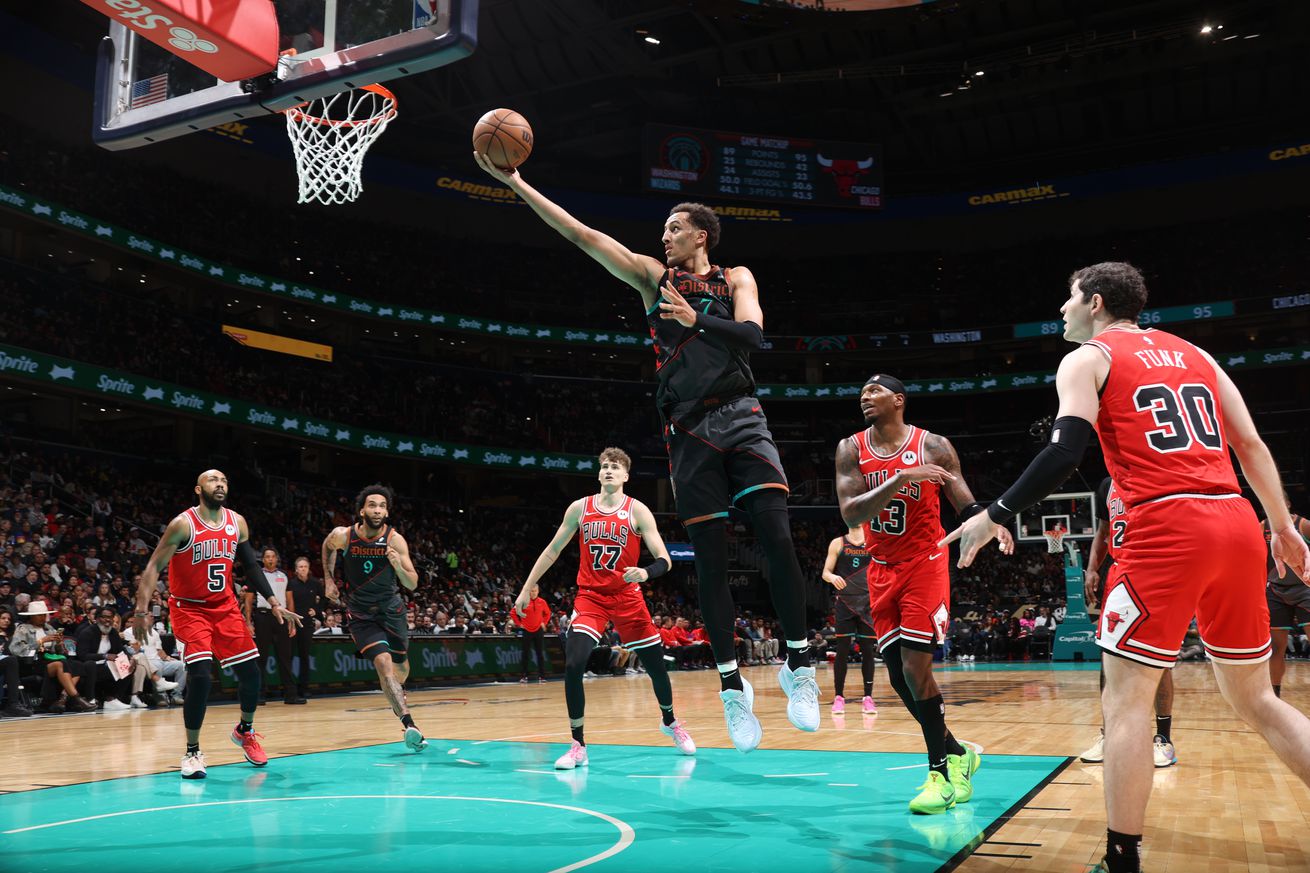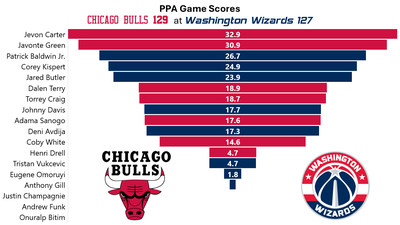
Stats, analysis, commentary.
Both teams were missing an array of regulars due to injury, illness, or indifference, but the Chicago Bulls and Washington Wizards played an entertaining and hard-fought game that the Bulls ultimately won.
The Wizards got to check off a few items on their late season wish list. Young guys made plays on the offensive end, and at least one major lineup experiment (Deni Avdija in a guard role) looked kinda interesting, even applying caveats about the quality of opposition.
Defense wasn’t exactly optional — both teams seemed to give solid effort at that end — but the lack of cohesiveness and the abundance of inexperienced youngsters showed in defensive execution.
This is probably a good time for the Recitation of Woes. Missing for Washington: Tyus Jones, Kyle Kuzma, Jordan Poole, Marvin Bagley III, Richaun Holmes, Bilal Coulibaly, and Landry Shamet.
Out for the Bulls: DeMar DeRozan, Nikola Vucevic, Alex Caruso, Andre Drummond, Ayo Dosunmu, and Julian Phillips, plus Zach LaVine, Patrick Williams, and Lonzo Ball.
In other words, neither team was dealing from a full deck. Which is fine — the Wizards are long eliminated from postseason contention, and the Bulls entered the night locked at ninth.
Musings & Observations
- “Point Deni” was interesting. This wasn’t against stalwart defense or quality defenders, but he got the team into their actions, looked for his own shot without being selfish, and made a concerted effort to set up teammates. He finished with 23 points, 12 rebounds, and 8 assists, and hit a nifty stepback three. Turnovers are an issue — he finished the night with four, and he missed a free throw in the final seconds that could have tied the game. Still, decent night from him as a leader of the offense.
- This was the best I’ve ever seen Patrick Baldwin Jr. play. He hit some threes, drove to the basket (even got a gliding dunk at one point), hit the boards (12 rebounds), and produced four assists.
- Corey Kispert had a solid all-around game — 23 points (including 6-11 on threes), 7 rebounds, 6 assists. His offensive efficiency (while still excellent overall) was dragged down by three turnovers.
- Jared Butler was excellent off the bench — 15 points on 9 shots, plus 10 assists and zero turnovers. Bulls analyst Stacey King proclaimed that, “Butler will be on someone’s roster [next season],” apparently unaware that Butler recently signed a three-year contract with the Wizards.
- Johnny Davis had what was probably the best game of his career. He hit 4-5 from three despite unorthodox form, and he had some nice moments defensively.
- Tristan Vukcevic started the game like the Bulls had done something to him — 3-3 from the floor (including a three), 4-5 from the free throw line, and a block. That’s 11 points, which he put up in 4:42 of playing time. The rest of the game wasn’t quite as productive. He’d finish with 19 points on 11 shots, but he committed three turnovers and four fouls. His best attribute at this point is that he tries to make plays. He sometimes succeeds and sometimes fails, but the attempt is what matters at this stage of his career.
- Washington’s season mop up crew rebounded just as badly as the regulars did. The Bulls outrebounded the Wizards 17-4 on the offensive glass, and 56-39 overall. They managed that while playing one 6-9 big — Adama Sanogo — who produced 10 offensive rebounds.
The Wizards finish their season Sunday against whoever dresses for the Boston Celtics.
Four Factors
Below are the four factors that decide wins and losses in basketball — shooting (efg), rebounding (offensive rebounds), ball handling (turnovers), fouling (free throws made).
Stats & Metrics
Below are a few performance metrics, including the Player Production Average (PPA) Game Score. PPA is my overall production metric, which credits players for things they do that help a team win (scoring, rebounding, playmaking, defending) and dings them for things that hurt (missed shots, turnovers, bad defense, fouls).
Game Score (GmSC) converts individual production into points on the scoreboard. The scale is the same as points and reflects each player’s total contributions for the game. The lowest possible GmSC is zero.
PPA is a per possession metric designed for larger data sets. In small sample sizes, the numbers can get weird. In PPA, 100 is average, higher is better and replacement level is 45. For a single game, replacement level isn’t much use, and I reiterate the caution about small samples sometimes producing weird results.
POSS is the number of possessions each player was on the floor in this game.
ORTG = offensive rating, which is points produced per individual possessions x 100. League average last season was 114.8. Points produced is not the same as points scored. It includes the value of assists and offensive rebounds, as well as sharing credit when receiving an assist.
USG = offensive usage rate. Average is 20%.
ORTG and USG are versions of stats created by former Wizards assistant coach Dean Oliver and modified by me. ORTG is an efficiency measure that accounts for the value of shooting, offensive rebounds, assists and turnovers. USG includes shooting from the floor and free throw line, offensive rebounds, assists and turnovers.
+PTS = “Plus Points” is a measure of the points gained or lost by each player based on their efficiency in this game compared to league average efficiency on the same number of possessions. A player with an offensive rating (points produced per possession x 100) of 100 who uses 20 possessions would produce 20 points. If the league average efficiency is 114, the league — on average — would produced 22.8 points in the same 20 possessions. So, the player in this hypothetical would have a +PTS score of -2.8.

